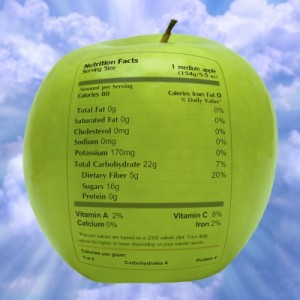Pump up the volume
The “Volumetrics” eating plan – have you heard of it? The premise has been around for a while and there’s a new book out by its creator, Barbara Rolls, but it’s not new news to most of us who’re long-time watchers of our weight. The basic premise is that people like to eat, and given a choice, they’d rather eat more than less. But filling up on high-calorie (or, “calorie-dense”) foods can cause weight gain, so what the Volumetrics approach does is have you fill up on low-density foods, so you can eat more, feel satisfied, and keep your weight in check.
Volumetrics relies heavily on foods with high water content, like most fruits and veggies, because they will fill you up without adding lots of calories. Foods with a lot of water (think soups, casseroles, stews, and fruit-based desserts) are great choices too. Volumetrics recipes also use a lot of tricks familiar to nutrition wonks and diet veterans: using less oil, butter, eggs, cream, and subbing in skim milk, egg whites, yogurt, and applesauce instead.
In addition to foods with high water content, fiber and lean protein and some healthy fats from fish and other sources can increase your feeling of fullness (or “satiety”). Energy-dense foods like sweets, fats, and alcohol are still allowed on the Volumetrics plan; you just have to eat them sparingly.
I basically follow a Volumetrics-like plan, and it keeps me feeling full, helps me maintain or lose weight (depending on my total calorie intake), and allows me to budget in some treats like chips/desserts/breads/etc. It’s a sensible diet that any nutritionist would recommend: lower-calories, lower fat, with lots of vegetables and fruits.
But hold up a minute. Some of the healthiest foods are calorie dense, so it’s important to learn the correct serving sizes before you go overboard. Here are some recommended portions so that you can try to adjust accordingly:
- Avocados: Sure, avocado is full of good fat, but you should stick to eating just half of the fruit (about 114 calories) to avoid over-do.
- Whole grain pastas/breads: When it comes to carbohydrates, complex is the way to go. With extra fiber, protein, and vitamins, they’re a crucial part of any diet. But one serving of pasta is only 1/2 cup dry, and that clocks in at around 200 calories. Not much bang for your buck, but sometimes you need pasta or bread. Or both. Trust me, I feel your pain.
- Nut butters: Packed with protein and healthy fats, nut butters are a yummy topping for fruits or sandwiches, and heck, they’re good straight from the jar. But a little goes a long way: Two measly tablespoons equals 200 calories! Use those measuring spoons to make sure you’re on track and not over-doing it.
- Dried fruit: Some tout these as a great way to satisfy your sweet tooth naturally, but these little sugar-nuggets pack a lot more calories than their fresh cousins. 1 cup of raisins has about 435 calories, whereas 1 cup of grapes has just about 100 calories. Now granted, you may not eat a whole cup of raisins in a sitting, but just ¼ c. has 100 calories . . . and if you’re combining that with other foods (like granola, for example), you need to watch your portion sizes.
- Spreads & Dips: It’s easy to go bananas with dips and spreads like hummus or cream cheese, and even though they can be a great source of protein and healthy fats, they can run upwards of 100 calories. A serving of hummus is usually 2 tablespoons – you can quickly exceed that, even if you’re scooping it up with über-healthy carrot sticks. Be sure to check labels and measure portion sizes.
- Cereals: A morning bowl of cereal is convenient and can help you get some whole grains and fiber into your diet, but watch serving sizes here – they can range from ¼ cup (hello, granola, I love you but cannot stop eating you!) to one cup. I don’t know about you, but even 1 cup of cereal won’t cut it for me in the a.m.
- Smoothies: You know me; I’m a BIG green smoothie fan. But you’ve gotta keep an eye on these, even if they’re packed with healthy stuff. Make your own so you can control what’s in there, or request nutritional information (or look it up on-line) from your favorite smoothie bar. You may be astounded at how many calories even an all-natural fruit smoothie can pack.
- Nuts & Seeds: Protein, fiber, etc. etc. etc. – nuts and seeds are little nutrition bullets. But it’s easy to go overboard. A 1 oz. serving (small handful) of nuts can have anywhere from 160-200 calories. Measure these out, weigh ‘em off . . . don’t sit with an open bag on your lap!
Whether you’re trying to lose weight or not, if you incorporate a greater number of low-density foods into your diet, you’ll never feel hungry or deprived, and chances are, you’ll be gaining nutritional benefits. Best yet, you’ll leave room in your diet for occasional sweets and other calorie-dense/nutritionally deficient (but delicious!) treats. By eating larger portions of low-energy-density foods, you squelch those hunger pains, take in fewer calories and feel better about your meal, which’ll leave you satisfied.
© 2012, Sarah. All rights reserved.











